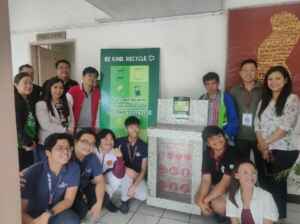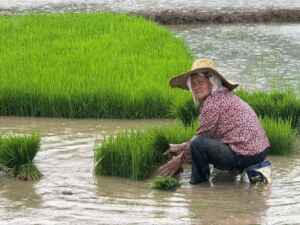NATIONAL DIRECTOR LUSTRIA JR. LEADS “ADIVAYAN” WITH IBALOI SAAD FISHERFOLK BENEFICIARIES IN TUBLAY, BENGUET

Along with BFAR staff, visited the BFAR SAAD projects in Tublay, Benguet.
In a meaningful engagement with the Ibaloi community, the Department of Agriculture Special Area for Agricultural Development (SAAD) Program Phase 2 National Program Management Support Office (NPMO) led by National Director Ulysses J. Lustria, Jr., conducted site visitation and monitoring activities in Tublay, Benguet on June 4, 2025. The monitoring team visited beneficiaries from the Ambongdolan Fisherfolk Association (AFA) in Barangay Ambongdolan and the Fisherfolk Organization of Daclan (FOOD) in Barangay Daclan, both newly organized fisherfolk associations in FY 2023 under the Bureau of Fisheries and Aquatic Resources – Cordillera Administrative Region (BFAR-CAR) SAAD.
The event was marked by a warm community gathering referred to in local Ibaloi culture as “adivayan”, or a friendly coming together. The NPMO team engaged beneficiaries in discussions about the selection of beneficiaries, their aquaculture ventures, tilapia as a culture commodity, the formation of their organizations, marketing practices, future plans for sustainability, and the impact of the SAAD program on their lives. “Kami ay napiling benepesyaryo ng SAAD dahil nabibilang kami sa fifth to sixth income class municipalities. Ang mga SAAD Area Coordinators kasama ang Local Government Unit ay dumating para ivalidate ang aming fishponds at ibang areas kung possible bang makapagpagawa ng fishpond (We were chosen as SAAD beneficiaries because we belong to fifth to sixth income class municipalities.
The SAAD Area Coordinators, together with the Local Government Unit, came to validate our fishponds and other areas to assess if it was possible to establish fishponds),” said AFA President Lacson B. Ignayon. According to AFA members, tilapia is the most marketable fish in the community and was introduced even before SAAD interventions came. But their tilapia grow-out culture venture began with the support of the SAAD program. They also highlighted the assistance they received through the KADIWA program and linkages to nearby municipalities such as Kapangan and Sablan. As part of their goals, the AFA members expressed their plan to establish an agri-fishery stall as a business for the association.
Due to Tublay’s topography, which mirrors much of the Cordilleras, fishponds are the primary aquaculture option. While some beneficiaries have existing fishponds, most were new to aquaculture. Through their acceptance of the program and by meeting the required qualifications, the AFA has set aside 2,900 square meters consolidated fishpond areas, while FOOD has 1,700 square meters. AFA consists of 25 members, including 12 males and 13 females, and FOOD has 15 members, having 10 males and 5 females. “Itong SAAD Program ay itinuturing namin na bendisyon, nagbigay ito ng additional income samin bukod sa pag-farming. Noon kasi, pang food consumption lang alaga naming isda, at matagal din silang lumalaki. Ngayong mayroon ng SAAD at complete siya, may isda, feeds at training, nakakabenta na kami at may kita na.
(We consider this SAAD Program a blessing because it provides us with additional income on top of our farming activities. Before, we only raised fish for food consumption, and they took a long time to grow. Now, with SAAD, we have complete fingerlings, feeds, and training, we can sell our fish and earn a profit),” beamingly explained FOOD Vice President Romel B. Bao-ed. FOOD members also shared their marketing strategies such as door-to-door deliveries targeting local stores and households, social media promotion and advertisement, and a unique approach of selling their produce to churchgoers on Sundays—often resulting in all items being sold out. A particularly inspiring story from the visit highlighted how many beneficiaries have expanded their fishponds, such as Mr. Rowel B. Sumalia.
According to Mr. Sumalia, he expanded his fishpond from the initial SAAD assisted area of 100 sqm to 700 sqm, investing part of his earnings from the program to fund fingerlings and feeds for this expansion. He shared that he chose to expand his fishpond because of the promising income, and it is less laborious, allowing him to manage it alongside his farming activities. The NPMO team commended this initiative, praising it as an example of how beneficiaries are taking ownership of the project by actively investing their own resources. This proactive approach not only strengthens their livelihood but also ensures the sustainability of the SAAD projects.
This site visit and monitoring activity by the national team aimed to engage directly with communities under the SAAD Program. It offered an opportunity for face-to-face discussions with beneficiaries, allowing the team to assess progress, identify challenges, and gather feedback to ensure the program’s effective implementation. Joining National Director Lustria Jr. from the NPMO were Executive Assistant Saturnino R. Palahang Jr., CAR-PME Focal Person Meljune A. Florece, and BFAR-PME Focal Person Ronalen J. Gonzales.
The team was also accompanied by the BFAR-CAR RPMSO, led by SAAD Program Coordinator Dr. Michelle A. Peralta, along with Aquacultural Technologist Leo Angeliko Jon Casing and Marketing Assistance and Enterprise Development Officer Maylyn B. Amlos. From PPMSO Benguet, Aquacultural Technologist Arnold M. Noces joined the visit, together with Area Coordinators Norielle C. De Olon, Wilson B. Cabais, and Alvinn C. Bokilis. The monitoring team was also assisted by LGU-Tublay through Fishery Coordinator Mr. Arfil A. Juan. As counterparts from the Department of Agriculture-CAR to visit DA SAAD project sites, the team included the DA RPMSO, led by SPPM Lead Dr. Aida Y. Pagtan, along with SAAD Assistant Operations Officer Ronan M. Soriano.
Community Billboard
PULIS KO,TITSER KO
July 5, 2025
MOTHER REUNITES WITH DAUGHTER AFTER SEVEN YEARS WITH NPA
June 28, 2025
FOUNDERS RUN MOVED TO AUGUST 9
June 28, 2025
A STUDENT JOURNEY THROUGH STRUGGLES AND HOPE
June 28, 2025
COURTESY VISIT
June 28, 2025






